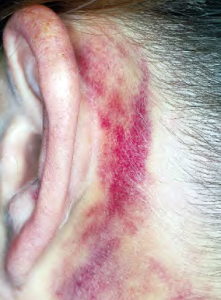

In most cases, the person is either unconscious or barely responsive. Severe head injury - There is serious damage to the outside of the head, often together with injuries involving the neck, arms or legs or major body organs.This fluid is not mucus, but fluid from around the brain (cerebrospinal fluid) that has leaked through a skull fracture near the nose. Other symptoms can include memory loss (amnesia), headache, dizziness, drowsiness, nausea and vomiting, confusion, a bruise-like discoloration around the eyes or behind the ear, or a clear fluid oozing from the nose. Moderate head injury - There is a more obvious injury to the outside of the head, and the person may have lost consciousness briefly.The injured person may vomit once or twice and complain of a headache. Mild head injury - There is minimal injury to the outside of the head, with no loss of consciousness.Some doctors classify head injuries into three categories, based on symptoms: Head injuries can cause a wide variety of symptoms, depending on the type of injury, its severity and its location. Up to 75% of people with severe head injuries also suffer serious damage to the neck bones or other parts of the body during the same injury. This is sometimes called "shell shock." Explosions cause a wave of changed atmospheric pressure, and brain movement within the skull can occur as a soldier recoils from a blast. Traumatic brain injury can also be caused by exposure to blast explosives in military combat, even if there is no direct contact with shrapnel. In the United States, the most common causes of head injuries are motor vehicle accidents, falls and violent assaults. Head trauma can cause swelling inside the brain and a potentially deadly increase in pressure inside the skull. This can cause harm in two places-one directly beneath the "hit", and a second area of damage on the opposite side of the brain.Ĭoncussion - If there are any symptoms of confusion, memory impairment or loss of consciousness after traumatic brain injury, the injury is called a "concussion." Symptoms of a concussion can include not having memory of the minutes immediately before the injury, temporarily losing consciousness, or having vomiting, dizziness, coordination problems, confusion, ringing in the ears, sleepiness or seizures. The force of an impact on one side of the brain can cause the brain to bounce or ricochet within the skull. A contusion is bruising in the brain-in a contusion, a bruise or an area of swelling can be seen on a CT scan but blood does not pool. Intraparenchymal hemorrhages and contusions- "Intraparenchymal" means "in the tissue." Intraparenchymal hemorrhage is pooling of blood that occurs within the brain tissue. The most common symptoms are drowsiness, inattentiveness or confusion, headaches, changes in personality, seizures and mild paralysis. Symptoms develop gradually over one to six weeks. A chronic subdural hematoma typically follows a fairly minor head injury in a person who is elderly, who is taking blood-thinning medications or whose brain has shrunk as a result of alcoholism or dementia.

It is a very severe brain injury that typically causes unconsciousness, and it is fatal in about 50% of cases.Ĭhronic subdural hematoma - Unlike the acute form, this type of subdural hematoma usually develops gradually because the bleeding inside the skull is less dramatic, and the hematoma can accumulate in several small, separate episodes of bleeding. Acute subdural hematoma develops rapidly, most commonly after serious head trauma caused by an assault, car accident or fall. This can happen when the head is hit or when a sudden stop causes the head to move violently forward and back (whiplash). The hematoma can expand within the skull and press on the brain, causing death.Īcute subdural hematoma - In this injury, a blood vessel tears, and blood collects between the dura and the surface of the brain. This collection of blood is called a hematoma. As the injured vessel bleeds, blood collects in the space between the skull and the dura, the outermost of the three membranes that cover the brain. In most cases, a skull fracture causes a bruise (contusion) on the surface of the brain under the fracture.Įpidural hematoma - This is a very serious form of bleeding that happens when one of the blood vessels under the skull is torn during an injury.

This is called a depressed skull fracture. In some cases, the skull is dented inward so that fragments of shattered bone are pressed against the surface of the brain.
#Skull fracture signs crack
Skull fracture - A skull fracture is a crack or break in one of the skull's bones. Trauma to the head can cause several types of head and brain injuries, also called traumatic brain injury (TBI).


 0 kommentar(er)
0 kommentar(er)
